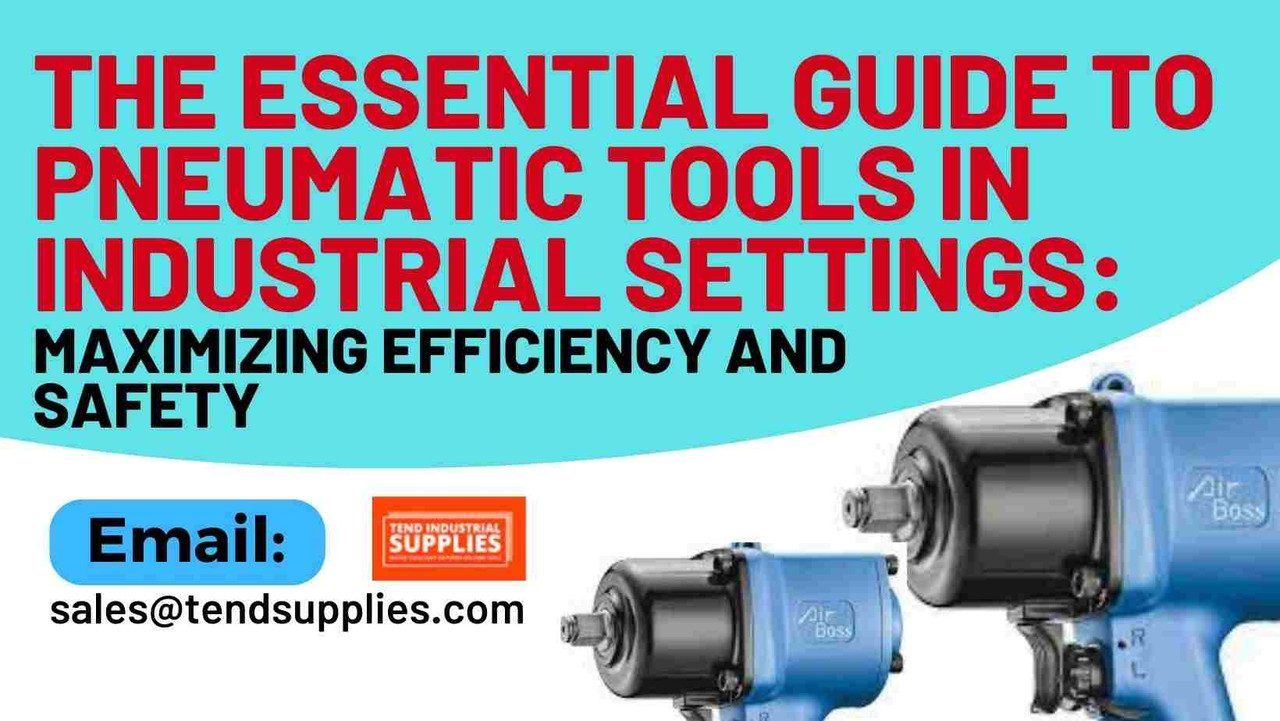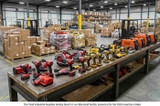The Essential Guide to Pneumatic Tools in Industrial Settings: Maximizing Efficiency and Safety
Key Takeaways:
- Pneumatic tools are essential in various industrial applications due to their reliability, efficiency, and safety.
- Choosing the right pneumatic tools involves considering performance needs, industrial applications, and environmental impact.
- Maintaining pneumatic tools is crucial for extending their life and ensuring safe operation.
- Advancements in technology are making pneumatic tools more efficient, safer, and environmentally friendly.
- Tend Industrial Supplies offers a wide range of pneumatic tools suitable for various industrial needs and is committed to providing sustainable and efficient solutions.
What Are Pneumatic Tools?
Pneumatic tools, also known as air tools, are powered by compressed air supplied by an air compressor. Their design allows for lighter, more compact tools that provide significant power and speed. Commonly found in garages, workshops, and industrial settings, these tools range from drills and hammers to sanders and polishers.
The Principle Behind Pneumatic Tools
The core principle of pneumatic tools is converting compressed air into mechanical work. Air enters the tool's chamber under high pressure and then expands, driving the tool's mechanism. This process results in a tool that is not only powerful but also reliable and easy to maintain.
Benefits of Pneumatic Tools in Industries
Pneumatic tools are lauded for their durability, reliability, and safety. They generate less heat and have a longer lifespan than their electric counterparts. Additionally, they are safer to use in wet or explosive environments, making them indispensable in various industrial applications.
Types of Pneumatic Tools in Industrial Applications
We will now introduce the most commonly used pneumatic tools in industrial settings, such as impact wrenches, drills, and grinders.
Handheld Pneumatic Tools
Handheld pneumatic tools are famous for their portability and versatility. Examples include pneumatic drills, grinders, and wrenches, which are used widely across industries for tasks requiring mobility and precision.
Pneumatic Power Tools
These tools are designed for heavy-duty applications and include items like pneumatic jackhammers and demolition tools. Their power and efficiency make them ideal for challenging industrial tasks.
Specialty Pneumatic Tools for Industrial Use
Specialized pneumatic tools cater to industry needs, such as pneumatic riveters in aircraft manufacturing or pneumatic conveyors in material handling. These tools are tailored to offer solutions that enhance productivity and safety in niche applications.
Pneumatic Tools in Manufacturing
Role in Assembly Lines
In assembly lines, pneumatic tools are essential for their speed and efficiency. They are used in the repetitive assembly of products, from automobiles to electronics, ensuring consistent quality and faster production times.
Pneumatic Tools for Material Handling
These include air balancers and hoists used for lifting and moving heavy materials. Their precision and ease of control improve operational efficiency and reduce the physical strain on workers.
Precision and Control in Manufacturing
Pneumatic tools provide unparalleled precision and control, essential in manufacturing processes that require exact specifications and tight tolerances. Their adjustable power output ensures that materials are handled delicately when necessary, reducing waste and improving quality.
Pneumatic Tools in Construction
Common Pneumatic Tools Used in Construction
In the construction industry, pneumatic tools such as nail guns, staplers, and jackhammers are indispensable. They accelerate the construction process and enhance the durability and integrity of the built structures.
Safety and Efficiency on the Construction Site
Safety is paramount in construction; pneumatic tools contribute significantly to a safer work environment. They reduce the risk of electric shock and minimize the fatigue associated with heavy lifting and manual labor.
Case Studies: Pneumatic Tools in Action
Real-world case studies demonstrate the effectiveness of pneumatic tools in construction projects. They highlight how these tools have led to faster completion times, reduced labor costs, and improved safety records in various construction scenarios.
Pneumatic tools are critical in industrial applications, offering efficiency, safety, and precision benefits. Whether in manufacturing, construction, or specialized industrial tasks, these tools provide solutions that enhance productivity and ensure workplace safety. As technology advances, the scope and capabilities of pneumatic tools are set to expand, further solidifying their place in industrial settings.
Pneumatic Tools in the Automotive Industry
Pneumatic tools are integral to the automotive assembly process, where precision and efficiency are paramount. These tools are used for fastening, drilling, and shaping parts, ensuring vehicles are assembled quickly and accurately. Their reliability and speed enhance assembly line productivity, leading to faster production rates and higher-quality vehicles.
Maintenance and Repair Tools
In automotive maintenance and repair, pneumatic tools provide mechanics with the power and versatility to perform various tasks. From impact wrenches used for removing tires to air ratchets for tight spaces, these tools decrease the time and effort required for vehicle repairs and maintenance.
Impact on Automotive Production Efficiency
Using pneumatic tools in automotive production lines significantly increases efficiency and consistency. The reduced physical strain on workers leads to lower fatigue and fewer injuries, while the tools' precision reduces the likelihood of errors, resulting in a more streamlined production process.
Maintenance of Pneumatic Tools
Regular maintenance is essential for the longevity and performance of pneumatic tools. This includes daily checks for air leaks, regular oiling and cleaning, and ensuring air filters and lubricators function correctly. Such maintenance ensures tools operate at peak efficiency and helps prevent unexpected breakdowns.
Troubleshooting Common Issues
Common issues with pneumatic tools include air leaks, power loss, and irregular tool operation. Identifying and addressing these problems promptly can prevent more significant issues. For example, replacing worn seals or O-rings can fix air leaks, restoring full power to the tool.
Extending the Life of Pneumatic Tools
Proper storage, regular maintenance, and using the correct air pressure can extend the life of pneumatic tools. Additionally, using the right tool for the job and avoiding overloading or improper use can prevent premature wear and tear.
Safety Measures for Pneumatic Tools
When using pneumatic tools, wearing appropriate personal protective equipment, such as safety goggles, ear protection, and glove, is crucial. This equipment protects users from potential hazards like flying debris, loud noise, and vibrations.
Best Practices for Safe Operation
Safe operation of pneumatic tools involves following manufacturer instructions, using tools within their design limits, and regularly inspecting tools for damage or wear. Additionally, ensuring a clean, dry air supply reduces the risk of tool malfunction and extends tool life.
Regulatory Standards and Compliance
Compliance with regulatory standards, such as OSHA guidelines in the United States, ensures that pneumatic tools are used safely and effectively. Adhering to these standards helps prevent workplace injuries and ensures a safe working environment.
Advancements in Pneumatic Tool Technology
Recent advancements in pneumatic tool technology include improved materials for increased durability, more efficient air motors for greater power output, and ergonomic designs to reduce operator fatigue. These innovations enhance the performance and usability of pneumatic tools in industrial applications.
Integration with Automation and Robotics
Pneumatic tools are increasingly integrated with automation systems and robotics in manufacturing processes. This integration allows for more precise control, increased production speeds, and reduced human error, leading to higher-quality products and more efficient production lines.
Future Trends in Pneumatic Tools
Future trends in pneumatic tool technology point towards smarter tools with IoT connectivity, enabling predictive maintenance and efficiency monitoring. Developing more environmentally friendly and energy-efficient tools aligns with global sustainability goals, indicating a green future for pneumatic tool technology.
Choosing the Right Pneumatic Tools
Factors to Consider
Selecting the right pneumatic tools involves assessing several factors, including the required performance, the specific industrial application, and the working environment. Additionally, the tool's air consumption, size, and weight should align with the user's needs and the capabilities of the existing air compressor system.
Comparison with Other Power Tool Technologies
When comparing pneumatic tools to other power tool technologies, such as electric or hydraulic, consider aspects like safety, power-to-weight ratio, and operational costs. Pneumatic tools offer superior safety in hazardous environments and provide a better power-to-weight ratio, although they require a constant air supply.
Recommendations for Different Industrial Applications
The choice of pneumatic tools can vary greatly depending on the industry. For example, in automotive assembly, precision and speed are key, while in construction, tools must be robust and versatile. Tend Industrial Supplies offers a wide range of pneumatic tools suitable for various applications, ensuring you find the perfect match for your specific needs.
Environmental Impact of Pneumatic Tools
Energy Efficiency and Consumption
Pneumatic tools can be more energy-efficient than their electric counterparts, especially when sourced from a centralized compressed air system. However, ensuring this system is leak-free and well-maintained is crucial for maximizing energy efficiency.
Noise Pollution and Solutions
While pneumatic tools can generate significant noise, solutions include using silencers, choosing low-noise models, and implementing sound-dampening measures in the workplace. These steps can significantly reduce noise pollution and improve the working environment.
Sustainable Practices in the Pneumatic Tool Industry
Adopting sustainable practices, such as using environmentally friendly lubricants and recycling compressed air, can minimize the environmental impact of pneumatic tools. Manufacturers are increasingly focusing on developing greener technologies to support these efforts.
Conclusion and Summary
Recap of Key Points
Pneumatic tools are vital in various industrial applications due to their reliability, efficiency, and safety. From manufacturing to construction, these tools enhance productivity and ensure high-quality results.
The Future of Pneumatic Tools in Industry
The pneumatic tool industry is evolving, with technological advancements leading to more efficient, safer, and environmentally friendly tools. This progression promises to expand their applicability and efficiency in industrial settings.
Final Thoughts and Recommendations
The importance of selecting the right tools and adopting sustainable practices cannot be overstated as we look towards the future. For businesses looking to equip their operations with high-quality pneumatic tools, Tend Industrial Supplies offers a comprehensive range to meet all your industrial needs. Explore our selection and take the first step towards enhancing your operational efficiency and environmental sustainability.
For personalized recommendations and more information, contact our expert team at sales@tendsupplies.com. Let us help you select the perfect pneumatic tools to drive your business forward.
FAQs:
What are pneumatic tools?
Pneumatic tools, or air tools, are powered by compressed air. They are used in various industrial applications for their power, reliability, and safety.
How do I choose the right pneumatic tool for my needs?
Consider the tool's required performance, the specific application, and the working environment. Evaluate the tool's air consumption and compatibility with your air compressor system.
How can I maintain my pneumatic tools?
Regular maintenance includes checking for air leaks, oiling, cleaning the tools, and ensuring air filters and lubricators are functioning correctly.
Are pneumatic tools environmentally friendly?
Pneumatic tools can be more energy-efficient and produce less waste than other power tools. Advances in technology are further reducing their environmental impact.
Where can I find high-quality pneumatic tools?
Tend Industrial Supplies offers a comprehensive range of pneumatic tools suitable for various industrial applications. Visit our website or contact sales@tendsupplies.com for more information.









